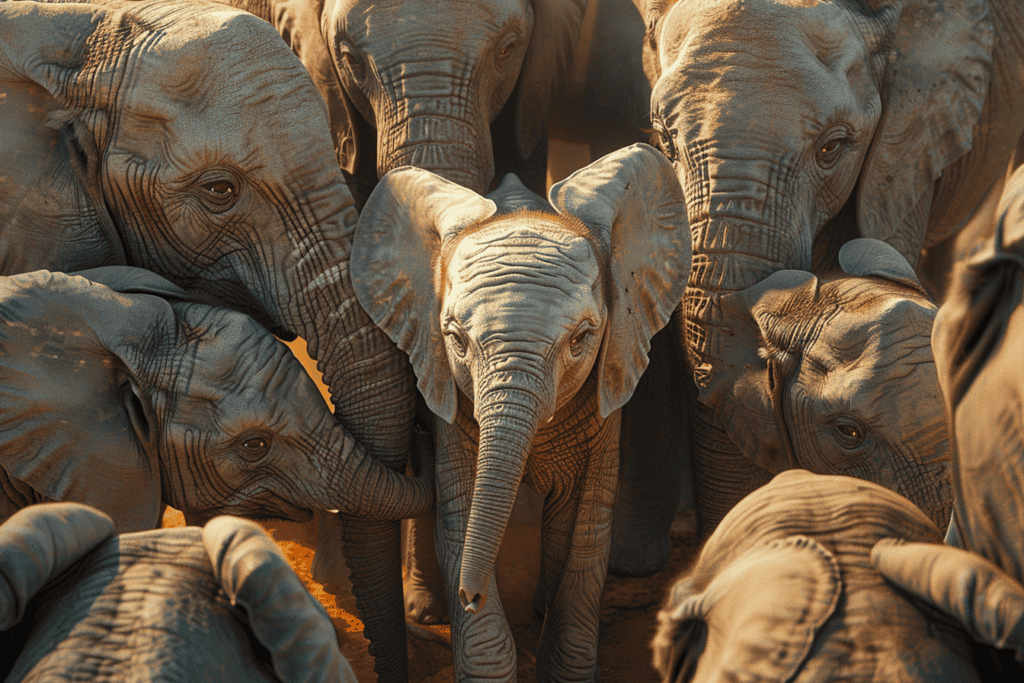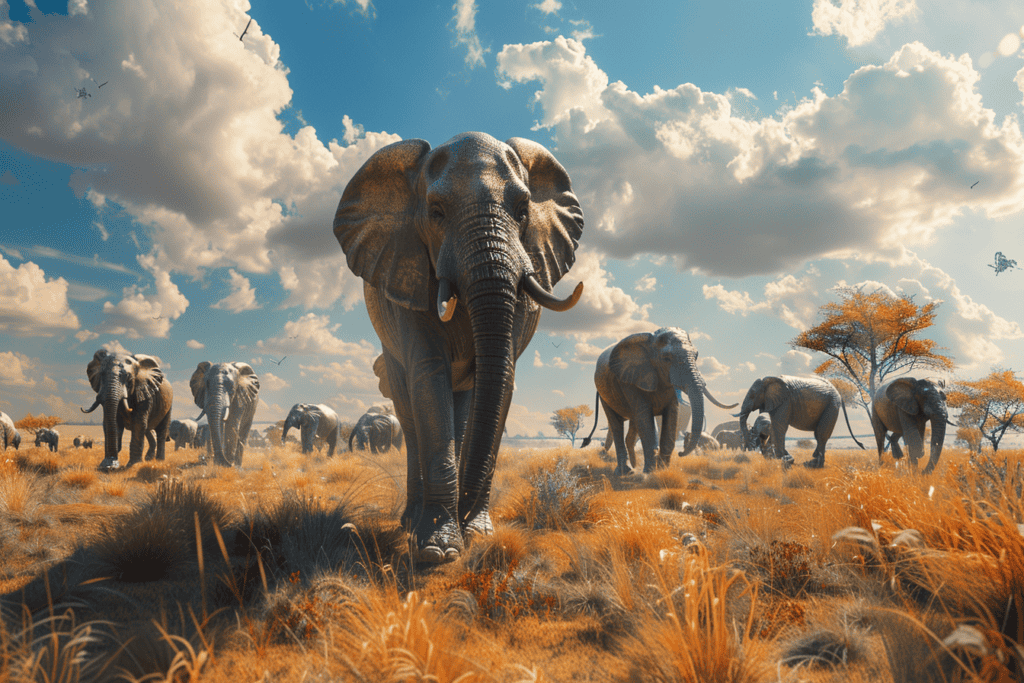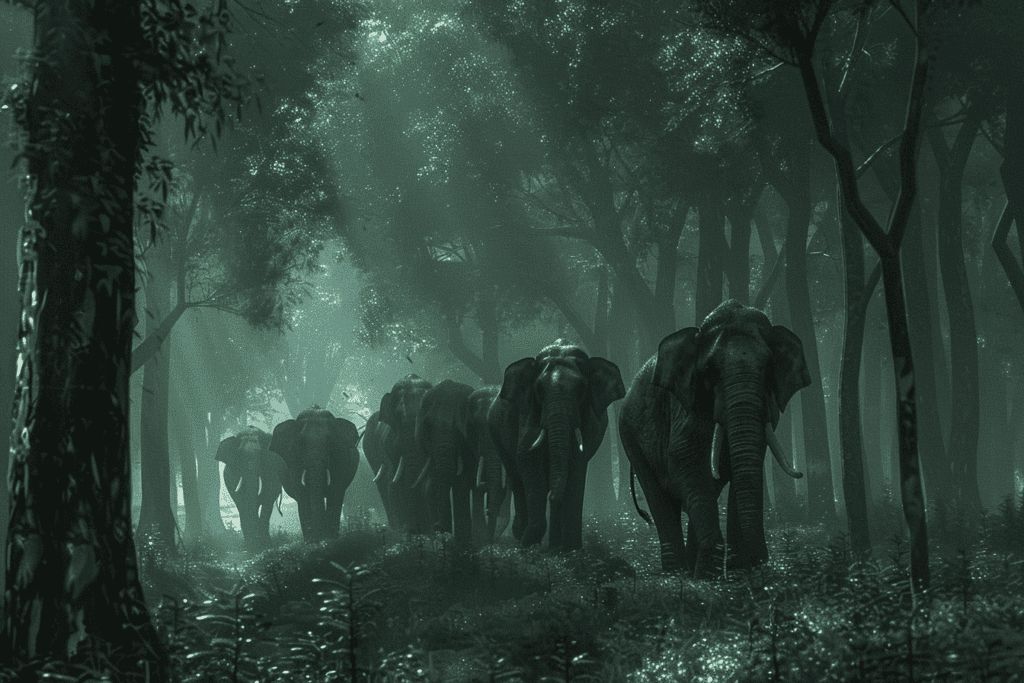Elephants are social giants led by a wise matriarch, often the eldest female who guarantees the herd’s survival by passing down vital knowledge about finding food and avoiding predators.
They exhibit incredible care and cooperation, nurturing each other’s young and working together to fend off threats. These bonds are vividly seen when they lose a member; elephants gather around the deceased, cover the body with soil or leaves, and show signs of grief like temporal gland streaming.
Their emotional intelligence shines as they revisit graves, touching remains with their trunks. Let’s dive deeper to uncover more about these sensitive, intelligent creatures.
Matriarchal Leadership
In elephant herds, the matriarch, usually the oldest female, leads with a wealth of wisdom essential for the group’s survival.
She’s not just an experienced leader; she’s the glue that holds the family together. Her knowledge about where to find food and water, and how to avoid predators, is indispensable for the herd’s well-being.
This wisdom is passed down to younger family members, ensuring the herd’s survival through generations.
As the matriarch navigates the group through the challenges of the wild, she fosters deep social bonds among the family members.
These bonds are fundamental, as elephants rely on their social structure for emotional support and cooperation.
The matriarch’s leadership helps maintain harmony and stability, guiding the herd with a firm yet nurturing presence.
When a matriarch dies, the next oldest female steps up, continuing the legacy of leadership and wisdom.
This seamless succession keeps the social hierarchy intact, demonstrating the resilience and adaptability of elephant herds.
Understanding the matriarch’s role helps you appreciate how essential her leadership is in maintaining the intricate social fabric and survival of these magnificent creatures.
Care and Cooperation

Elephant families often care for each other’s young, showcasing remarkable communal parenting and cooperation.
You’ll find that these social creatures thrive on strong bonds and mutual support.
When you observe an elephant herd, you’ll see older matriarchs leading and guiding the younger members, safeguarding their safety and growth. These matriarchs play a pivotal role in teaching and protecting the herd, proving just how essential their presence is.
Female elephants are especially cooperative, often banding together to shield and care for each other. They guarantee the well-being of the entire group, demonstrating a level of empathy and teamwork that’s truly inspiring.
By working together, they can fend off predators and tackle challenges that would be insurmountable alone.
In elephant societies, this care and cooperation aren’t just about survival; they’re about thriving as a community.
Each member of the herd relies on the others, creating a network of support and protection. This interconnectedness highlights the depth of their social structures and the strength of their bonds.
Mourning Rituals

Often displaying remarkable sensitivity, elephants engage in intricate mourning rituals when a member of their herd passes away. When elephants grieve, they show an emotional depth that’s both touching and profound.
You’ll notice them gathering around the deceased, with each elephant taking a turn to inspect the body. This investigation, where they distinguish between elephant remains and those of other animals, is a vital part of their mourning process.
Elephants have been observed covering the bodies with soil, leaves, and branches. They may even attempt to lift and carry the remains, demonstrating a deep connection to their lost kin.
Signs of distress are often visible, such as liquid streaming from their temporal glands, indicating the emotional weight of their grief.
The fascination calves show as they walk past and smell the carcass underscores the importance of this ritual in their social structure. In some instances, elephants have mistakenly mourned a living person, showering them with debris, highlighting their strong emotional responses to death.
These mourning rituals not only offer a glimpse into their complex emotions but also emphasize the strong bonds within elephant herds, which play a pivotal role in their social cohesion.
Emotional Intelligence

Their intricate mourning rituals offer a window into the remarkable emotional intelligence elephants possess.
You can observe these majestic creatures displaying behaviors that suggest a deep understanding and emotional depth. Elephants demonstrate empathy by comforting one another, especially when a member of their herd is distressed. They touch, embrace, and offer reassuring gestures, highlighting their complex social structure.
Elephant behavior also includes using tools, mimicking sounds, and solving problems, which showcases their cognitive abilities. They don’t just live; they interact in sophisticated ways that suggest a high level of awareness. Emotional intelligence in elephants is evident as they exhibit human-like emotions such as anxiety, fear, joy, and sorrow.
When a family member dies, their mourning isn’t just a fleeting moment; it’s a profound experience that can last for days, reflecting their strong bonds and deep emotional connections.
Elephants also have an impressive memory, enabling them to recall events from years past. This memory aids in their social interactions and emotional responses, allowing them to navigate complex relationships within their groups.
Returning to Graves

When mourning the loss of a herd member, these majestic creatures often return to the gravesite, displaying behaviors that suggest a deep emotional connection.
Elephants have been observed visiting the graves of their family members with an eerie stillness, touching the remains gently with their trunks.
This act of revisiting the graves signifies more than just curiosity; it’s a profound display of grief and mourning.
Elephants may perform what resemble burial rituals, covering the bodies with soil, leaves, and branches.
These rituals aren’t limited to family members alone; elephants have been known to mourn the death of non-relatives as well.
Their powerful sense of empathy was once highlighted when they mistakenly mourned a living person, showering them with debris.
The emotional depth of elephants is further evidenced by their behavior upon returning to graves.
They often show signs of grief, such as rejecting food, isolating themselves, and even guarding the body of the deceased.
The way elephants interact with their dead is unique and distinct from other animals, suggesting a complex emotional response to death and mourning that underscores their remarkable social bonds.
Frequently Asked Questions
How Do Elephants Communicate With Each Other Over Long Distances?
They use infrasound communication, which includes vocal rumbling and seismic signals. These low-frequency sounds travel miles, allowing elephants to stay connected even when far apart.
What Role Do Male Elephants Play in the Social Structure?
Male elephants play a limited social role. They often act as lone bulls, occasionally joining bachelor herds. Dominance hierarchy influences mating rituals, but they don’t participate in daily care of the young or complex social structures.
How Do Young Elephants Learn Essential Survival Skills?
Young elephants learn essential survival skills through maternal guidance, play behavior, and sibling interactions. You’ll see them imitating older females, learning foraging techniques, and practicing social behavior, all vital for their development and survival.
What Is the Typical Lifespan of an Elephant in the Wild?
Elephants’ lifespan in the wild varies. African elephants live 50-70 years, sometimes into their 80s. Asian elephants live 40-50 years, occasionally reaching 60. Lifespan comparison highlights age milestones and elder care’s impact on longevity.
How Do Environmental Changes Impact Elephant Social Dynamics?
Environmental changes impact elephant social dynamics by causing habitat loss, climate change, and human encroachment. These factors disrupt matriarchal herds, force elephants into human areas, alter migration patterns, and reduce genetic diversity, weakening their social bonds.









